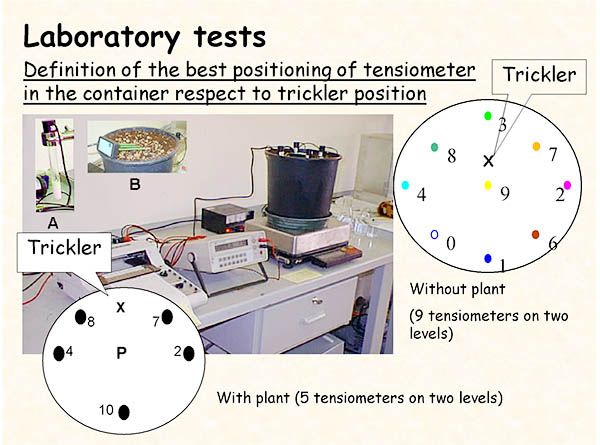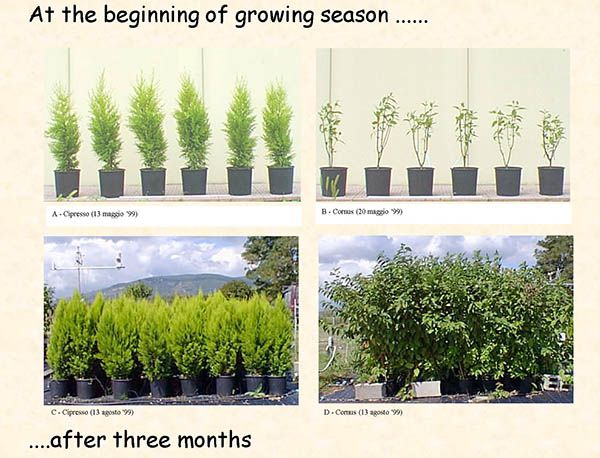The cultivation of ornamental and horticultural crops needs elevated water amount. Since the problem of water shortage and water quality becomes more and more important year-by-year, new solutions have to be introduced to rationalize water consumption avoiding water shortage periods and water quality worsening (e.g. increasing water salinisation).
The usual practice of irrigation for container crops does not take into account real plant water requirements, entrusting the control to simple systems like timers. The detection of soil water potential in pots is one of the possible techniques to adapt water supply to real plant exigencies, reducing water consumption, without negative effects on the plants.
Work aims
- To verify the potentialities of tensiometers to automate irrigation of container crops in order to optimize water use (to save water without affect plant growth)
- To define the methodology of water providing
- To define the best positioning of tensiometer in the container respect to trickler position
Some information about Materials and Methods
- Container volume: 9 litres
- Substratum: peat and pumice (1:1)
- Species of ornamental plants:
- Cupressus macrocarpa Var. Golden crest (high growth rate and low water exigencies. Resistant to long dry period)
- Cornus alba Var. Sibirica (very high growth rate and very high water exigencies. Extremely sensitive to dry period)
- Tensiometer size: length: 100 mm diameter: 13 mm

Definition of methodology of water providing
- Threshold of soil water potential for watering activation: 70 hPa
- Water amount to be distributed to restore field capacity: 1.5 litres
Distribution of water according to the following procedures:
- in a single watering
- two watering of 0.75 L each at an interval of 10 min
- three watering of 0.5 L each at an interval of 10 min (six repetitions for each watering cycle)
Field experiments
- Two years of experiments: 1999 and 2000
- Two treatments for each species:
- reference treatment: irrigation controlled by timer (two daily irrigations at 9:00 and 18:00; water amount of 1.5 L distributed in a unique dose. A third daily irrigation was introduced late in the season when plants, for their dimensions, could suffer water shortage)
- treatment with the irrigation controlled by tensiometers: (water amount of 1.5 L distributed according to laboratory experiment results):
-
-
- Twelve plants per treatment
- Soil water potential of three plants per treatments was measured in continuum by tensiometers. Only the readings of one tensiometer were used to active irrigation.
- Threshold value of soil water potential for watering activation: 70 hPa
-
The tensiometers dedicated to watering control were connected to an electronic card, developed on purpose, able to read tensiometers values and to start/stop irrigation according to threshold value and protocol introduced in card software, turning on/off relative electric valves. The other tensiometers were connected to a datalogger.
The protocol foresaw three watering of 0.5 L each at an interval of 10 min. Each irrigation cycle was followed by a control of soil water potential. If the value was higher than 25 hPa (stop threshold) new waterings were applied until stop threshold was reached.
Measurements taken on 12 plants per treatment during the growing season to verify plant conditions:
- plant height
- collar diameter
- leaf temperature (by IR thermometer)
- stomatal resistance (by a steady-state porometer)
Final measurements: fresh and dry biomass

Results
Methodology of water providing
Water amount stored and lost during each watering for the three tests (mean±sd).
| Test | Water amount distribuited (L) | Water stored for each watering (L) | Total water stored (L) | Total water lost (L) |
| 1° | 1.5 | 0.740 ± 0.1 | 0.740 ± 0.1 | 0.760 |
| 2° | 0.75 + 0.75 | 0.612 ± 0.07 + 0.144 ± 0.04 | 0.756 ± 0.1 | 0.744 |
| 3° | 0.5 + 0.5 + 0.5 | 0.476 ± 0.04 + 0.276 ± 0.08 + 0.104 ± 0.04 | 0.856 ± 0.1 | 0.644 |



